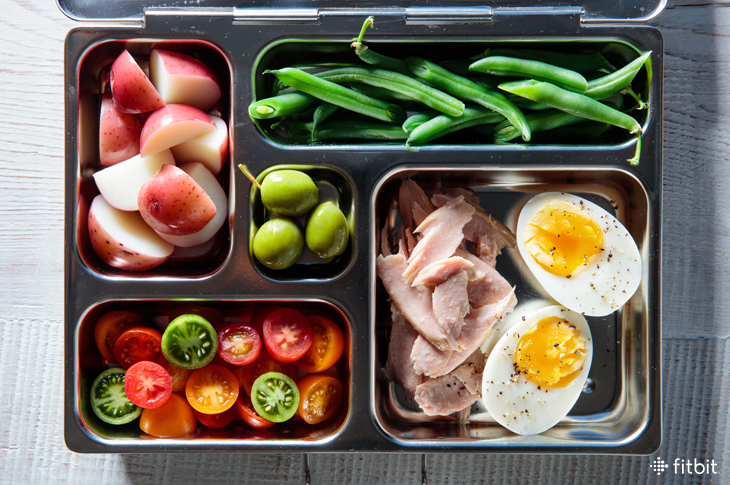 Artfully arranged, perfectly balanced, and uniquely suitable for desk dining, ekiben, the beautiful bento boxes sold in Japanese train stations, put American’s ho-hum lunchboxes to shame. These boxed grab-and-go meals are housed in special divided containers and beautifully wrapped in printed paper. Inside, a carefully balanced meal sits arranged like a painter’s palette. Bento Boxes are a feast for the eyes, but making your own bento lunches can offer more than just looks. “Packing a bento box can help you create a nutrient-rich, balanced and portion-controlled meal,” says Detroit-based dietitian Caroline Margolis, RD.
Artfully arranged, perfectly balanced, and uniquely suitable for desk dining, ekiben, the beautiful bento boxes sold in Japanese train stations, put American’s ho-hum lunchboxes to shame. These boxed grab-and-go meals are housed in special divided containers and beautifully wrapped in printed paper. Inside, a carefully balanced meal sits arranged like a painter’s palette. Bento Boxes are a feast for the eyes, but making your own bento lunches can offer more than just looks. “Packing a bento box can help you create a nutrient-rich, balanced and portion-controlled meal,” says Detroit-based dietitian Caroline Margolis, RD.
Here, five bento-culture takeaways that can help you step up your lunchbox game.
1. Set the “table.” Sitting down to a homemade lunch arranged in a beautiful bento box focuses your senses on the meal, which studies have shown can help with digestion and weight loss. “Mixed on a plate, it’s easy to not appreciate what is in front of you and easier to over-consume,” says Margolis. “Eating from a bento box allows us to slow down, appreciate the crunch or the beauty of the ingredients in front of us.”
The boxes themselves come in a wide array of wooden, lacquered, plastic, or metal models; some even include a thermos for soup or green tea, a cold pack to help keep foods cool, chopsticks or sporks, and a color-coordinated napkin. The nifty compartments also serve as built-in portion control.
2. Stick with seasonal foods. The Japanese are acutely aware of the changing seasons and celebrate the time of year by eating local, in-season foods. Part of this is ascetic tradition, but eating seasonally also makes sense from a taste and an economic standpoint. When you pack a lunch with local, seasonal fruits and vegetables, you’re eating foods that don’t require a long transport time to your plate—typically making them more affordable and the epitome of fresh. Savoring the beginning of spring with delicate asparagus spears, the height of summer with a simple tomato salad, the coming of autumn with a butternut squash salad, and winter with cozy root vegetable soup can add more enjoyment to every meal.
3. Vary textures. Instead of containing one uniform thing, say a sandwich or one big bowl of salad, Japanese bento boxes include several small portions of different dishes with a focus on balancing textures, flavors, and cooking methods (think: a soft rice ball wrapped in nori seaweed, crunchy pan-fried gyoza, simmered mixed vegetables lightly glazed in soy sauce). A variety of textures doesn’t just make a meal fun to eat, research also shows it can help with satiety. According to a study in Appetite, when people eat a texturally complex meal, they tend to feel full faster than when they eat a low-texture meal with the same amount of flavor and calories.
4. Eat with your eyes. Japanese cooks intentionally vary the colors of ingredients in bento boxes to make them visually appealing. Generally, each bento box will include a white food (often rice), a yellow food (such as a small portion of omelet), a red food (shrimp, pickled ume plum for instance), a green food (like spinach salad or cooked greens), and a black food (fish or a nori seaweed-wrapped rice ball). How can this color assortment help you? Studies show that diners rate artfully plated food as being tastier than sloppily arranged meals prepared with identical ingredients, and that diners tend to assign more value to food that looks appetizing. This diversity of colors leads the eye around the box, adding anticipation to the meal, but it also fits neatly into the “eat the rainbow” tenant recommended by the American Heart Association as a way to consume a variety of nutrients.
5. Keep it simple. Making a Japanese bento-inspired lunch doesn’t mean you have to get up at the crack of dawn to painstakingly arrange cartoon kitty faces on your rice or cut out tiny carrot flowers for every bite of salad (though that can be fun if you’re into it). When assembling a bento for yourself, adding visual appeal can be as easy as putting a halved cherry tomato in a dark corner of the box to add little pop of appetizing red or garnishing grilled fish with a thin half-moon slice of lemon and a rumple of pickled ginger. To vary texture, add a small cup of roasted almonds, a handful of edamame sprinkled with crunchy sea salt, or a little cup of creamy chia pudding to your bento. It just takes a bit of planning, a creative use of leftovers, and a little internet inspiration.
Hungry for more? Check out 7 Quick and Healthy Lunch Ideas for School or Work for more bento box lunch ideas!
This information is for educational purposes only and is not intended as a substitute for medical diagnosis or treatment. You should not use this information to diagnose or treat a health problem or condition. Always check with your doctor before changing your diet, altering your sleep habits, taking supplements, or starting a new fitness routine.

If you have questions about a Fitbit tracker, product availability, or the status of your order, contact our Support Team or search the Fitbit Community for answers.
Please note: Comments are moderated and may not appear immediately after submission.